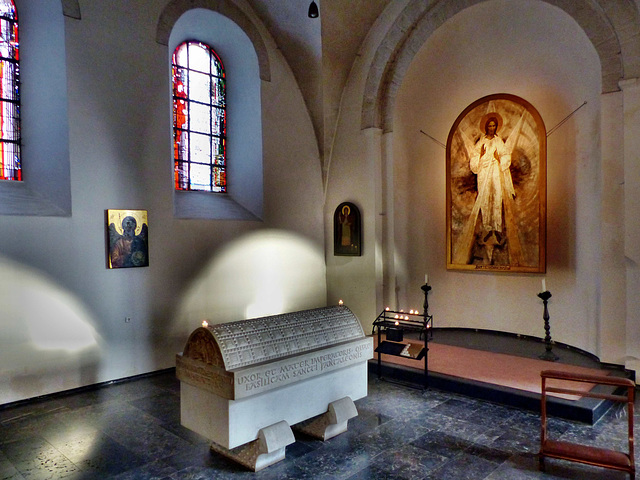Location
Keywords
Authorizations, license
-
Visible by: Everyone -
All rights reserved
-
138 visits
Cologne - St. Pantaleon


Cologne is the fourth-largest city in Germany - and one of the oldest. A Germanic tribe, the Ubii, had a settlement here, this was named by the Romans "Oppidum Ubiorum". In 50 AD, the Romans founded "Colonia Claudia Ara Agrippinensium", the city then became the provincial capital of "Germania Inferior".
A Roman villa once occupied the hill on which the church stands. Around 870 the first church got erected here and in 955 Archbishop Bruno the Great (brother of Emperor Otto the Great) added a Benedictine abbey. . In 966, work was begun on a new church to go with the monastery. The church was consecrated in 980. During the construction the bones of St. Maurinus were discovered.
Holy Roman Empress Theophanu, who was married to Emperor Otto II in 972, ordered the construction of the current facade.
The monastery was dissolved after Cologne was occupied by French forces in 1794. The church served as a horse stable, and, when Cologne became Prussian in 1815, as a Protestant garrison church.
The tomb of Theophanu, niece of the Eastern Roman Emperor Johannes I. Tzimiskes and wife of Otto II. His father Otto I had the idea of unifying the eastern and the western empires, so he sent delegations to Constantinople in order to win over a Byzantine princess as consort to his son. Finally Gero, Archbishop of Cologne, was successful but instead of the desired Emperor´s daughter he brought young Theophanu to Italy. Some advisors recommended to sent her away, but Otto I could not follow the advice, considering the relationship with Byzantium.
Theophanu and Otto II were married by Pope John XIII in April 972 and she was crowned as Holy Roman Empress the same day in Rome.
Otto II succeeded his father in 973. Theophanu accompanied her husband on all his journeys an achieved a privileged position with influence in affairs of the empire.
Theophanu was criticized for her "decadence", manifested in her bathing and introducing new luxurious garments and jewelry into the royal court. She is credited with introducing the fork to Western Europe.
Otto II died suddenly on 7 December 983 at the age of 28. Three-year-old Otto III had already been appointed King of the Romans. Theophanu had him crowned at Aachen Cathedral, with herself ruling as Empress Regent on his behalf.
Theophanu ruled the Empire for five years, from May 985 to her death in 990. Her first act as regent was securing her son, Otto III, as the heir to the Holy Roman Empire. Theophanu also placed her daughters in power by giving them high positions in influential nunneries all around the Ottonian-ruled west, securing power for all her children.
She was for sure one of the most important women of the middle ages.
A Roman villa once occupied the hill on which the church stands. Around 870 the first church got erected here and in 955 Archbishop Bruno the Great (brother of Emperor Otto the Great) added a Benedictine abbey. . In 966, work was begun on a new church to go with the monastery. The church was consecrated in 980. During the construction the bones of St. Maurinus were discovered.
Holy Roman Empress Theophanu, who was married to Emperor Otto II in 972, ordered the construction of the current facade.
The monastery was dissolved after Cologne was occupied by French forces in 1794. The church served as a horse stable, and, when Cologne became Prussian in 1815, as a Protestant garrison church.
The tomb of Theophanu, niece of the Eastern Roman Emperor Johannes I. Tzimiskes and wife of Otto II. His father Otto I had the idea of unifying the eastern and the western empires, so he sent delegations to Constantinople in order to win over a Byzantine princess as consort to his son. Finally Gero, Archbishop of Cologne, was successful but instead of the desired Emperor´s daughter he brought young Theophanu to Italy. Some advisors recommended to sent her away, but Otto I could not follow the advice, considering the relationship with Byzantium.
Theophanu and Otto II were married by Pope John XIII in April 972 and she was crowned as Holy Roman Empress the same day in Rome.
Otto II succeeded his father in 973. Theophanu accompanied her husband on all his journeys an achieved a privileged position with influence in affairs of the empire.
Theophanu was criticized for her "decadence", manifested in her bathing and introducing new luxurious garments and jewelry into the royal court. She is credited with introducing the fork to Western Europe.
Otto II died suddenly on 7 December 983 at the age of 28. Three-year-old Otto III had already been appointed King of the Romans. Theophanu had him crowned at Aachen Cathedral, with herself ruling as Empress Regent on his behalf.
Theophanu ruled the Empire for five years, from May 985 to her death in 990. Her first act as regent was securing her son, Otto III, as the heir to the Holy Roman Empire. Theophanu also placed her daughters in power by giving them high positions in influential nunneries all around the Ottonian-ruled west, securing power for all her children.
She was for sure one of the most important women of the middle ages.
Nicole Merdrignac has particularly liked this photo
- Keyboard shortcuts:
Jump to top
RSS feed- Latest comments - Subscribe to the comment feeds of this photo
- ipernity © 2007-2024
- Help & Contact
|
Club news
|
About ipernity
|
History |
ipernity Club & Prices |
Guide of good conduct
Donate | Group guidelines | Privacy policy | Terms of use | Statutes | In memoria -
Facebook
Twitter

Sign-in to write a comment.